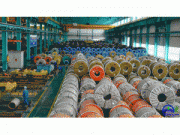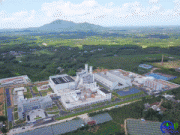免职声明:本网站为公益性网站,部分信息来自网络,如果涉及贵网站的知识产权,请及时反馈,我们承诺第一时间删除!
This website is a public welfare website, part of the information from the Internet, if it involves the intellectual property rights of your website, please timely feedback, we promise to delete the first time.
电话Tel: 19550540085: QQ号: 929496072 or 邮箱Email: Lng@vip.qq.com
摘要:经过20多年发展,我国现代煤化工技术和产业规模总体已处于国际领先地位。去年6月,国家发改委等六部门联合发布《关于推动现代煤化工产业健康发展的通知》(以下简称《通知》),提出要加强煤炭清洁高效利用,推动现代煤化工产业高端化、多元化、低碳化发展。搭建从煤..
|
经过20多年发展,我国现代煤化工技术和产业规模总体已处于国际领先地位。去年6月,国家发改委等六部门联合发布《关于推动现代煤化工产业健康发展的通知》(以下简称《通知》),提出要加强煤炭清洁高效利用,推动现代煤化工产业高端化、多元化、低碳化发展。 搭建从煤向化工品转化的桥梁
国家能源集团、中国石化、中煤能源、陕煤化集团等大型国有骨干企业作为重大项目研发和示范实施主体,与中科院大连化物所、中科院山西煤化所、煤炭科学研究总院等科研单位开展联合攻关,开发了一系列具有自主知识产权的原创性技术,建成一批重大示范工程,成功搭建了从煤炭资源向油气和化工品转化的桥梁。 去年3月,国家重点研发计划“低二氧化碳选择性合成气直接转化制长链α—烯烃成套技术”项目启动。据了解,该项目由国家能源集团北京低碳清洁能源研究院牵头,通过气化技术把煤炭转为合成气,再通过催化手段,将合成气转化成长链α—烯烃混合物并提纯。该项目预期形成年产10万吨的长链α—烯烃制取技术,实现我国煤炭清洁转化的高端化、多元化、低碳化,解决我国长链α—烯烃对外依存度过高的问题。 煤炭资源优势地区也在加速推动煤化工向高端化、低碳化、多元化迈进。以煤炭大省山西为例,去年7月,山西省发改委、省工信厅和省能源局联合印发《推进煤炭和煤化工一体化发展的指导意见》提出,山西省将打造10条煤化工重点产业链,包括两条高端碳材料产业链、两种碳基合成材料产业链、两条煤焦化苯系材料产业链、两条煤基储能材料产业链、一条低阶煤分质清洁利用联产产业链和一条高端化学品及化工新材料产业链。 处在发展关键时期 多位专家指出,在碳达峰碳中和背景下,我国煤化工产业整体面临多重压力,只有瞄准高端化、多元化、低碳化发力,才是最终出路。 中国石油和化学工业联合会会长李寿生此前公开指出,当前,我国现代煤化工的发展正处在一个关键时期,面临着二氧化碳排放、水资源短缺、终端产品雷同和环境治理四大挑战。我国现代煤化工面临的全新挑战,也创造了开创世界煤化工发展第四个里程碑的机会,在“双碳”目标的新形势下,走出一条高碳原料低碳排放、二氧化碳资源化利用的新路子。 “经过这些年的市场洗礼,煤化工产业也深刻认识到,只有在高端化、多元化和低碳化上实现突破,产业才有未来。通过高端化发展,煤化工产业才能避免与石油化工直接竞争的劣势;通过多元化发展,煤化工企业才有抵御市场风险的能力;通过低碳化发展,煤化工产品才能拿到未来市场的入场券。”石油和化学工业规划院副院长李志坚此前表示。 多位业内专家指出,最近两三年规划的煤化工项目明显比此前呈现出更鲜明的高端化、多元化特征,产品链延伸了许多、产品类型也复杂了许多。 值得注意的是,为更好地引导产业走向高端化、多元化、低碳化,此前六部门发布的《通知》也强调,进一步加强规划引导,优化产业布局,推动存量现代煤化工项目加快实施先进技术装备改造升级,新建煤制烯烃、煤制对二甲苯(PX)、煤制甲醇、煤制乙二醇、煤制可降解材料等项目重点向煤水资源相对丰富、环境容量较好地区集中,促进产业集聚化、园区化发展。 持续推动技术创新 推动煤化工产业进一步走向高端化、低碳化、多元化,技术创新是根本。 李寿生认为,要坚持创新引领。未来煤化工产业高端化、多元化、低碳化发展靠的是技术创新,目前技术创新仍有较大的空间。同时,要坚持发展模式创新。例如,气化岛创新模式,煤化工与氯碱工业、纺织工业、绿电等耦合,煤化工园区化、基地化、产业链协同发展等。 “在现有基础上不断推动技术进步,提升产业发展水平,赋能企业在高端化、多元化和低碳化上实现突破。”李志坚指出,比如,在产品高端化和多元化方面,开发与α—烯烃共聚的聚乙烯、ULDPE及丙丁共聚聚丙烯、融熔聚丙烯、高结晶度聚丙烯等新牌号聚烯烃树脂;与石油化工技术耦合生产乙烯、丙烯下游产品延伸产业链;开发合成气直接催化合成烯烃、芳烃、支链烷烃以及醇类含氧化合物技术。在低碳化方面,开发更多更好的节能新工艺、新技术、新设备,提高单位资源产出,提升能源资源利用效率,降低排放,实现资源的高效清洁转化。 After more than 20 years of development, China's modern coal chemical technology and industrial scale have been in the international leading position. In June last year, the National Development and Reform Commission and other six departments jointly issued the "Notice on Promoting the Healthy Development of Modern coal chemical Industry" (hereinafter referred to as the "Notice"), proposing to strengthen the clean and efficient use of coal and promote the high-end, diversified and low-carbon development of modern coal chemical industry. Bridge the transition from coal to chemicals In recent years, China's modern coal chemical industry has developed rapidly, and the production capacity and output of main products remain the first in the world. Data show that in 2023, China's coal (methanol) olefin production capacity will be 18.65 million tons, an increase of 17.9% compared with 2019; Coal-to-gas production capacity of 6.71 billion cubic meters, an increase of 33.3% over 2019; Coal to ethylene glycol production capacity of 11.18 million tons, an increase of 131.5% compared with 2019; Coal-to-oil production capacity was 11.38 million tons, an increase of 23.56% over 2019. China National Energy Group, Sinopec, China Coal Energy, Shaanxi Coal Chemical Group and other large state-owned backbone enterprises as the main research and development and demonstration implementation of major projects, with the Dalian Institute of Chemical Sciences, the Shanxi Institute of Coal Research, the Chinese Academy of Sciences and other scientific research institutions to carry out joint research, develop a series of original technologies with independent intellectual property rights, built a number of major demonstration projects. It has successfully built a bridge from coal resources to oil, gas and chemicals. In March last year, the national key research and development program "low carbon dioxide selective syngas direct conversion to long chain alpha-olefin complete technology" project was launched. It is understood that the project, led by the National Energy Group Beijing Low carbon Clean Energy Research Institute, converts coal into syngas through gasification technology, and then converts syngas into a long chain α-olefin mixture and purification through catalytic means. The project is expected to form an annual output of 100,000 tons of long-chain α-olefin production technology, to achieve the clean transformation of China's coal high-end, diversified, low carbonization, to solve the problem of China's long chain α-olefin external dependence is too high. Regions with advantages in coal resources are also accelerating the advancement of coal chemical industry to high-end, low carbonization and diversification. In July last year, the Shanxi Development and Reform Commission, the provincial Department of Industry and Information Technology and the provincial Energy Bureau jointly issued the Guiding Opinions on Promoting the Integrated Development of Coal and Coal Chemical Industry, proposing that Shanxi will build 10 key industrial chains of coal chemical industry. It includes two industrial chains of high-end carbon materials, two industrial chains of carbon-based synthetic materials, two industrial chains of coal-coking benzene materials, two industrial chains of coal-based energy storage materials, one industrial chain of low-rank coal separation and clean utilization and co-production, and one industrial chain of high-end chemicals and new chemical materials. At a critical stage of development Many experts pointed out that in the context of carbon peak carbon neutrality, China's coal chemical industry as a whole is facing multiple pressures, only aiming at high-end, diversified, low carbonization power, is the final way out. Li Shousheng, president of China Petroleum and Chemical Industry Federation, publicly pointed out that at present, the development of modern coal chemical industry in China is at a critical period, facing four major challenges: carbon dioxide emissions, water shortages, identical end products and environmental governance. The new challenges faced by China's modern coal chemical industry have also created an opportunity to create the fourth milestone in the development of the world's coal chemical industry, and under the new situation of the "double carbon" goal, a new way of low carbon emissions of high carbon raw materials and resource utilization of carbon dioxide has been developed. "After years of market baptism, the coal chemical industry has also deeply realized that only in high-end, diversified and low-carbon breakthroughs, the industry has a future." Through high-end development, coal chemical industry can avoid the disadvantage of direct competition with petrochemical industry; Only through diversified development can coal chemical enterprises have the ability to resist market risks. Through low-carbon development, coal chemical products can get the entrance ticket to the future market." Li Zhijian, vice president of the Petroleum and chemical Industry Planning Institute, said earlier. Many industry experts pointed out that the coal chemical project planned in the last two or three years has obviously shown a more distinctive high-end and diversified characteristics than before, and the product chain has extended many and the product types have become more complex. It is worth noting that in order to better guide the industry to high-end, diversified and low-carbon, the "Notice" issued by the previous six departments also stressed that it should further strengthen planning and guidance, optimize the industrial layout, and accelerate the implementation of advanced technology and equipment upgrading of modern coal chemical projects. The new coal-to-olefin, coal-to-p-xylene (PX), coal-to-methanol, coal-to-ethylene glycol, coal-to-degradable materials and other projects focus on areas with relatively rich coal water resources and good environmental capacity, and promote industrial agglomeration and park development. Continue to promote technological innovation To promote the coal chemical industry to further high-end, low carbonization, diversification, technological innovation is fundamental. Li Shousheng believes that we should adhere to innovation and lead. In the future, the high-end, diversified and low-carbon development of coal chemical industry depends on technological innovation, and there is still a large space for technological innovation. At the same time, we must continue to innovate the development model. For example, the gasification island innovation model, coal chemical industry and chlor-alkali industry, textile industry, green electricity coupling, coal chemical industry park, base, industrial chain coordinated development. "On the existing basis, we will continue to promote technological progress, improve the level of industrial development, and empower enterprises to achieve breakthroughs in high-end, diversified and low-carbon." Li Zhijian pointed out that, for example, in terms of product high-end and diversification, the development of polyethylene copolymerized with α-olefin, ULDPE and polypropylene copolymerized, melt polypropylene, high crystallinity polypropylene and other new grades of polyolefin resins; Coupling with petrochemical technology to produce ethylene and propylene downstream products to extend the industrial chain; The technology of direct catalytic synthesis of alkenes, aromatics, branched alkanes and alcohols containing oxygen compounds was developed. In terms of low carbonization, the development of more and better energy-saving new processes, new technologies, new equipment, improve unit resource output, improve energy and resource utilization efficiency, reduce emissions, and achieve efficient and clean transformation of resources. |




 近年来,我国现代煤化工产业发展迅速,主要产品产能、产量保持在世界第一。数据显示,2023年我国煤(甲醇)制烯烃产能为1865万吨,较2019年增长17.9%;煤制气产能67.1亿立方米,较2019年增长33.3%;煤制乙二醇产能1118万吨,较2019年增长131.5%;煤制油产能1138万吨,较2019年增长23.56%。
近年来,我国现代煤化工产业发展迅速,主要产品产能、产量保持在世界第一。数据显示,2023年我国煤(甲醇)制烯烃产能为1865万吨,较2019年增长17.9%;煤制气产能67.1亿立方米,较2019年增长33.3%;煤制乙二醇产能1118万吨,较2019年增长131.5%;煤制油产能1138万吨,较2019年增长23.56%。












